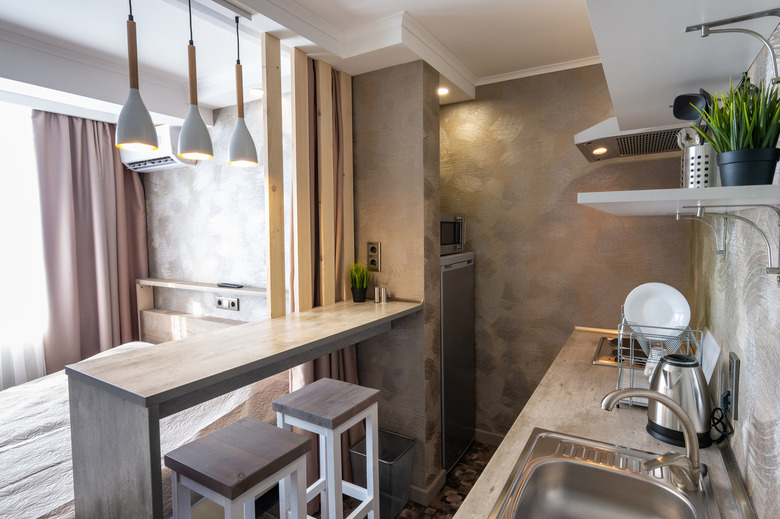How To Hang Fluorescent Light Fixtures
We may receive a commission on purchases made from links.
Hanging fluorescent lights in your home, workshop or garage is easy to do with a few simple tools. You'll need a stud finder, measuring tape, drill and a sturdy step stool or ladder. The mounting hardware should be included with your light fixture. Hard wiring the unit (if needed) represents the only tricky part of the process and should only be performed by a licensed electrician.
Finding Ceiling Studs
Finding Ceiling Studs
Whether you're installing flush mount LED shop lights or hanging fluorescent lights from chains, it's best to mount them to ceiling studs for the strongest connection. Use a stud finder to scan the ceiling for the location of the studs and mark the edges of each one in the vicinity of where you want to hang the fluorescent light.
Next, measure the distance between the screw holes on the mounting bracket and measure this same distance on the ceiling starting in the center of one of the ceiling studs. With any luck, you'll intersect another ceiling stud where the next screw hole is located. Mark this location. If there are multiple options for screw holes, it can be useful to create a paper template to quickly see which ones line up with the ceiling studs.
Now you need to make sure that the light will look straight once it's hung. Measure from the parallel wall to the mark on the first ceiling stud. Move over to each ceiling stud that will receive a screw and measure this same distance. Your fluorescent light fixture will now look perfectly in line with the walls.
Hanging Fluorescent Lights
Hanging Fluorescent Lights
With the position of the screw holes marked on the ceiling, it's time to put on safety goggles and drill pilot holes. You may want a helper to hold the fluorescent fixture flush with the ceiling while you drill in the screws. Note that if you cannot find matching ceiling studs, use toggle bolts to secure the light fixture, not drywall anchors. Even if you have drywall anchors rated for the weight of the light fixture, Warehouse-Lighting.com points out that they are only suitable for horizontal use, not for ceiling suspension.
For fluorescent light fixtures that hang from a chain, you'll drill eyelets into the ceiling studs rather than screws. Use an eyelet drill attachment or start the eyelet by hand, pass a screwdriver through the eye, and use it as leverage to turn the eyelet clockwise until all the threads have sunk into the stud. Then, use S hooks to attach the chains to the eyelets.
Connecting to a Power Source
Connecting to a Power Source
Some fluorescent lights are designed to be plugged into an outlet. A ceiling-mounted outlet is ideal so that you do not have to awkwardly position the cord or use an extension cord. If needed, keep the cord tucked out of the way with cable staples.
To convert a single fixture light to a shop light that's hardwired, you'll need to connect the existing wires to the fixture's wires. Call a licensed electrician to complete this step. Also, call a pro if there are no existing wires or switches where you want to install a hardwired fluorescent light fixture.
Some fixtures cover the wires with a decorative panel. These typically snap into place, but other models will be held on with screws.
Installing Light Bulbs and Diffuser
Installing Light Bulbs and Diffuser
All that's left to do is install the fluorescent light bulbs and attach the diffuser to soften and disperse the light. Use light bulbs with the voltage recommended by the fixture's manufacturer. Most fluorescent lights simply snap into place with a gentle push on either end.
According to Exceptional Electric, the diffuser screen may be held on with clips, slide on from the side or hang from a lip on either side of the hanging fluorescent light fixture. Some may also be attached with small screws.
